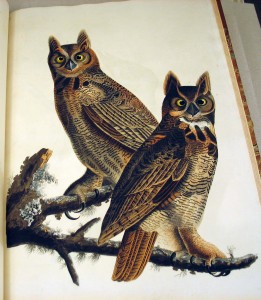[This lovely plate will be on view until January 11]
 “It is during the placid serenity of a beautiful summer night, when the current of the waters moves silently along, reflecting from its smooth surface the silver radiance of the moon, and when all else of animated nature seems sunk in repose, that the Great Horned Owl, one of the Nimrods of the feathered tribes of our forests, may be seen sailing silently and yet rapidly on, intent on the destruction of the objects destined to form his food. The lone steersman of the descending boat observes the nocturnal hunter, gliding on extended pinions across the river, sailing over one hill and then another, or suddenly sweeping downwards, and again rising in the air like a moving shadow, now distinctly seen, and again mingling with the sombre shades of the surrounding woods, fading into obscurity. The bark has now floated to some distance, and is opposite the newly cleared patch of ground, the result of a squatter’s first attempt at cultivation, in a place lately shaded by the trees of the forest. The moon shines brightly on his hut, his slight fence, the newly planted orchard, and a tree, which, spared by the axe, serves as a roosting-place for the scanty stock of poultry which the new comer has procured from some liberal neighbour. Amongst them nests a Turkey-hen, covering her offspring with extended wings. The Great Owl, with eyes keen as those of any falcon, is now seen hovering above the place. He has already espied the quarry, and is sailing in wide circles meditating his plan of attack. The Turkey-hen, which at another time might be sound asleep, is now, however, so intent on the care of her young brood, that she rises on her legs and purrs so loudly, as she opens her wings and spreads her tail, that she rouses her neighbours, the hens, together with their protector. The cacklings which they at first emit soon become a general clamour. The squatter hears the uproar, and is on his feet in an instant, rifle in hand; the priming examined, he gently pushes open his half-closed door, and peeps out cautiously, to ascertain the cause by which his repose has been disturbed. He observes the murderous owl just alighting on the dead branch of a tall tree, when, raising his never-failing rifle, he takes aim, touches the trigger, and the next instant sees the foe falling dead to the ground. The bird is unworthy of his farther attention, and is left a prey to some prowling opossum or other carnivorous quadruped. Again, all around is tranquility. In this manner falls many a Great Horned Owl on our frontiers, where the species abounds.”
“It is during the placid serenity of a beautiful summer night, when the current of the waters moves silently along, reflecting from its smooth surface the silver radiance of the moon, and when all else of animated nature seems sunk in repose, that the Great Horned Owl, one of the Nimrods of the feathered tribes of our forests, may be seen sailing silently and yet rapidly on, intent on the destruction of the objects destined to form his food. The lone steersman of the descending boat observes the nocturnal hunter, gliding on extended pinions across the river, sailing over one hill and then another, or suddenly sweeping downwards, and again rising in the air like a moving shadow, now distinctly seen, and again mingling with the sombre shades of the surrounding woods, fading into obscurity. The bark has now floated to some distance, and is opposite the newly cleared patch of ground, the result of a squatter’s first attempt at cultivation, in a place lately shaded by the trees of the forest. The moon shines brightly on his hut, his slight fence, the newly planted orchard, and a tree, which, spared by the axe, serves as a roosting-place for the scanty stock of poultry which the new comer has procured from some liberal neighbour. Amongst them nests a Turkey-hen, covering her offspring with extended wings. The Great Owl, with eyes keen as those of any falcon, is now seen hovering above the place. He has already espied the quarry, and is sailing in wide circles meditating his plan of attack. The Turkey-hen, which at another time might be sound asleep, is now, however, so intent on the care of her young brood, that she rises on her legs and purrs so loudly, as she opens her wings and spreads her tail, that she rouses her neighbours, the hens, together with their protector. The cacklings which they at first emit soon become a general clamour. The squatter hears the uproar, and is on his feet in an instant, rifle in hand; the priming examined, he gently pushes open his half-closed door, and peeps out cautiously, to ascertain the cause by which his repose has been disturbed. He observes the murderous owl just alighting on the dead branch of a tall tree, when, raising his never-failing rifle, he takes aim, touches the trigger, and the next instant sees the foe falling dead to the ground. The bird is unworthy of his farther attention, and is left a prey to some prowling opossum or other carnivorous quadruped. Again, all around is tranquility. In this manner falls many a Great Horned Owl on our frontiers, where the species abounds.”
–J. J. Audubon, Ornithological Biography, I (1831), 313-314 [excerpted].